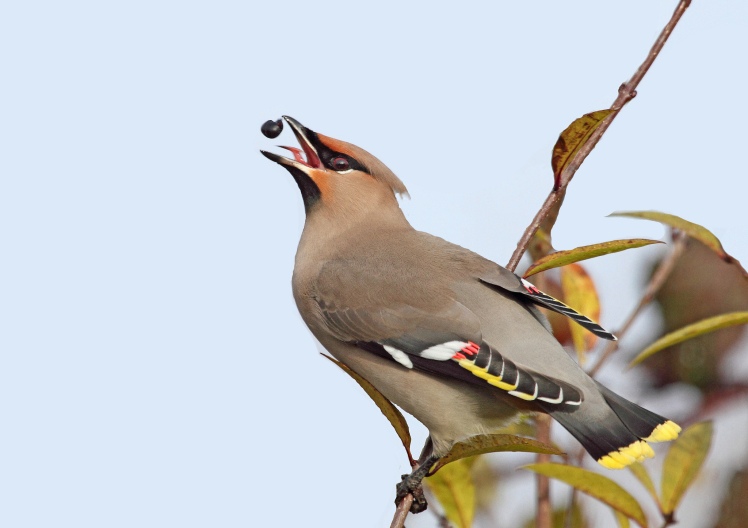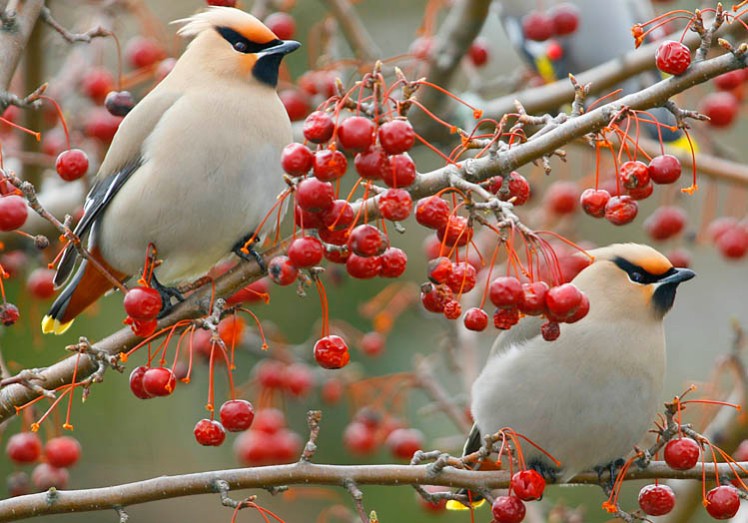In Round 2, the clash between Australia’s Mistletoe Bird and the Britain’s European Robin came to a draw! So now we’re on to the appropriately named ‘featherweight’ category.
Zoologist Jones has put forward the highly energetic New Holland honeyeater as their contestant for Round 3, let’s see if we can beat that!
Swooping into the British corner, we have the Bohemian waxwing (Bombycilla garrulus)!

The Winter Visitor
Bohemian waxwings are winter visitors to Britain and are most often seen between October and April. With an average weight between 45 and 69g, the waxwing is definitely pushing the upper boundary of our featherweight limit (20-50g), but I couldn’t resist squeezing them in to our competition. Their body plumage is ashy-brown, but their wings and tails are ornamented with black and yellow tips. They also have a black bandit-like mask across their eyes and chin, with a delightful pointed crest atop their head.
Waxwings are named so because the red tips on their wings appear similar to the drops of red sealing wax that have historically been used on letters and envelopes. The Bohemian part of their name comes from their nomadic nature, as they are constantly travelling in search of berries.

Berry, Berry Greedy
In the winter, waxwings gorge themselves on berries, typically eating up to 1000 berries every day. Waxwings have a strong preference for the berries of our native rowan trees, but they also enjoy hawthorn, cotoneaster and rosehips. They tend to arrive in the North-East of Scotland and England and make their way south through the British Isles as they consume all the berries they can find.

When they’re feeding in groups, they are very vocal and produce a high-pitch trill which you can hear below. However, they don’t tend to have territorial calls when in Britain due to their nomadic nature.
Partying Passerines
It’s not just about foraging, they also know how to have a good time! Or at least, an accidental good time… Due to their high intake of berries, it’s not unusual for bohemian waxwings to eat berries that have started to ferment, which leads to them getting rather tipsy and a little bit wobbly when it comes to flying. Luckily, evolution has provided them with a highly efficient liver so they can get back to the skies in no time.
Quite unlike Round 2’s contestant, the European robin, waxwings are very sociable and often cooperate in flocks to find berries. Unsurprisingly, waxwing romance is also built on…. yup, berries. During courtship, male waxwings will pass females a berry between their beaks, which she will then pass back. This berry-passing continues a number of times, supposedly strengthening the bond between the pair.
So that’s it for Round 3! Britain’s berry-ravaging Bohemian Waxwing or Australia’s energetic New Holland Honeyeater? The winner is up to you!
— Featured Image Credit: Sveinn Jonsson / Flickr —

Some great shots here
LikeLiked by 1 person
Your photos are fantastic, I’m actually planning on picking the greater spotted woodpecker for the next round, love your most recent shots!
LikeLiked by 1 person
Thank you, she was very accommodating last weekend
LikeLiked by 1 person
I vote waxwing!
LikeLiked by 1 person
I like a bird that enjoys a tipple so Waxwing for me please
LikeLiked by 1 person
Great and I especially love that video! Keep up the good work.
LikeLiked by 1 person
Thanks!
LikeLike
Hope to see one someday. Great shots.
LikeLiked by 1 person